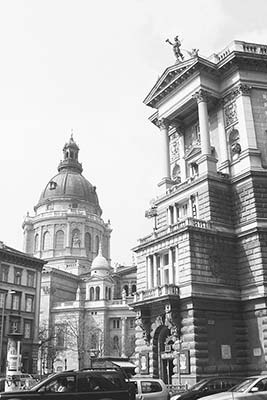
From Deák Tér to Heroes' Square
Millennium Underground of 1896
Hungarian State Opera House (Magyar Állami Operaház)
Franz Liszt Square (Liszt Ferenc Tér)
Former Academy of Music (Franz Liszt Museum) and Puppet Theater
Connecting downtown Pest to City Park, Andrássy út is Budapest’s main boulevard, lined with plane trees, shops, theaters, cafés, and locals living very well. Budapesters like to think of Andrássy út as the Champs-Elysées and Broadway rolled into one. While that’s a stretch, it is a good place to stroll, get a feel for today’s urban Pest, and visit a few top attractions (most notably the Opera House and the House of Terror) on the way to Heroes’ Square and City Park.
(See "Andrássy Út Walk" map, here.)
Length of This Walk: Allow an hour, not including time to enter the sights.
Overview: Andrássy út is divided roughly into thirds. The most interesting first section (from Deák tér to the Oktogon) is the focus of this walk. The middle section (between the Oktogon and Kodály körönd) features one major sight, the House of Terror. The final third (Kodály körönd to Heroes’ Square), while pleasant and comparatively low-key, offers fewer sightseeing opportunities.
Shortcut: The M1/yellow Metró line runs every couple of minutes just under the street—so it’s easy to skip several blocks ahead, or to backtrack (stops marked by yellow signs).
Getting There: The walk begins at Deák tér—easy to reach from anywhere in the city, as it’s on three Metró lines. If you’re coming from Vörösmarty tér in central Pest, simply hop the M1/yellow Metró line one stop, or walk five minutes up Deák utca. If you want to skip to the start of Andrássy út itself, you can ride the M1 to the Bajcsy-Zsilinszky út stop and start this walk at the “Millennium Underground of 1896” section.
Opera House: Lobby free to enter Mon-Sat 11:00 until show time—generally 19:00, or until 17:00 if there’s no performance, on Sun open 3 hours before the performance—generally 16:00-19:00, or 10:00-13:00 if there’s a matinee; tours-2,900 Ft, 600 Ft extra for 5-minute mini-concert following the tour, 45 minutes, in English nearly daily at 15:00 and 16:00, June-Oct maybe also at 14:00—buy tickets at shop inside lobby and to the left, shop has slightly shorter hours than lobby; Andrássy út 22, tel. 1/332-8197.
House of Terror: 2,000 Ft, possibly more for special exhibits, audioguide-1,500 Ft, Tue-Sun 10:00-18:00, closed Mon, last entry 30 minutes before closing, Andrássy út 60, tel. 1/374-2600, www.terrorhaza.hu.
Franz Liszt Museum: 1,300 Ft, audioguide-700 Ft; Mon-Fri 10:00-18:00, Sat 9:00-17:00, closed Sun; performances in concert hall Sat at 11:00, Vörösmarty utca 35, tel. 1/322-9804, www.lisztmuseum.hu.
Starring: Budapest’s most elegant drag, with fine architecture, upscale shopping, great restaurants, and top-notch sightseeing—from opulent (Opera House) to sobering (House of Terror).
Nearby Eateries: For restaurants near Andrássy Út see here.

(See "Andrássy Út Walk" map, here.)
• Begin in the middle of the paved square (near the M2 and M3 Metró entrances) called...
This square is named for Ferenc Deák (1803-1876), a statesman who pushed for persistent international pressure on the Habsburgs to improve Hungary’s status after his rabble-rousing compatriots failed in the 1848 Revolution. (The peace-loving Deák was sort of a Hungarian Jimmy Carter.) It worked. With the Compromise of 1867, Hungary was granted an impressive measure of autonomy in the empire.
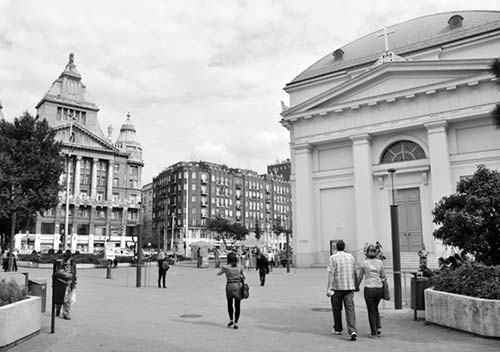
Sitting unassumingly on the square is the blocky, typically austere Lutheran church, with its Neoclassical colonnade entry and shallow green dome. Looming over the square across the street is the landmark, but sadly neglected, yellow office block called the Ankerház. Like the square it dominates, this building isn’t as important as it might seem.
On the upper part of the square (up the stairs) is an angular memorial to Gábor Sztehlo, a Lutheran pastor who rescued approximately 2,000 local Jews from the Arrow Cross regime during the Holocaust. Hungarian officials understandably love to celebrate these (relatively rare) “righteous Gentiles” who came to the rescue of the Jews. (For more on the Holocaust in Hungary, see here.)
• From Deák tér, cross Harmincad street—the one with all the bus stops (including one to Memento Park, explained on here)—and head for...
This pretty, leafy park was Pest’s main market square. It’s named for one of Deák’s contemporaries: Elisabeth, the wife of the Habsburg Emperor Franz Josef. While Deák pressed Franz Josef with diplomacy, Empress Elisabeth (a.k.a. Sisi) pressured him at home...Hungarian autonomy was one of her pet issues (for more on this “royal and imperial” couple, see here).
The park was long marred by the presence of a gloomy, polluting, communist-era international bus station. But now it has been reclaimed as a welcoming public zone, and the bus station has been converted into the Design Terminal (with a gallery and studios) and lively Fröccsterasz outdoor bar/café. Deeper in the park, in the summertime you may see the Budapest Eye, a Ferris wheel that offers an overpriced (but scenic and romantic) spin over the rooftops of the city center.
Notice there are two parts to Erzsébet tér: the more traditional park behind the former bus station and a sleek, modern new area in front of it. A few years ago, the government planned to build a new national theater in this spot, and they even began to dig the foundation. But when the parliament changed hands, construction was aborted—leaving a giant hole that locals called “The National Ditch.”
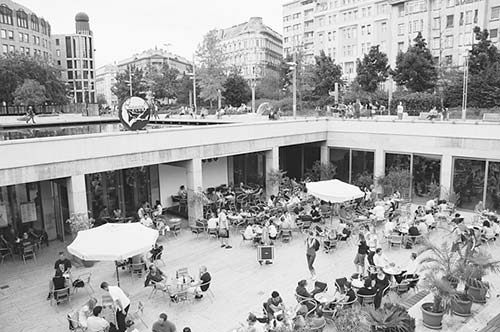
Eventually they came up with a creative use for the space: an underground parking garage and a unique café/nightclub. Walk closer to the low wall at the end of the park near the busy street and look down (at the end facing Deák tér): A long series of terraces filled with café tables leads down into the Akvárium nightclub. On balmy summer nights, outdoor performances take place here, and this whole area is filled with young locals. The incline leads to the indoor, underground part of the café. Walk a little farther through the park to reach the artificial pond that covers part of the ditch. Look closely: Especially at night, you can see through the glass floor of the very shallow pond and spot people walking around in the underground nightclub. (For more, see here.)
• At the far corner of Erzsébet tér (past the ditch and the rack of loaner Bubi bikes), cross the busy Small Boulevard (here called Bajcsy-Zsilinszky út) to the beginning of Andrássy út. For now, stay on the right side of the boulevard. You’ll pass a heavenly smelling stand selling a delicious Hungarian treat, kürtőskalács—a “pastry horn” that’s slow-cooked on a rotisserie, then rolled in cinnamon, coconut, or other toppings. Be sure to get one that’s hot and fresh. A few steps farther along, look for the yellow railings on either side of the street with the low-profile Földalatti sign. This marks the Bajcsy-Zsilinszky út Metró stop. Go down the steps and back more than 100 years (if they ask you for your Metró ticket, just take a peek, then head back up).
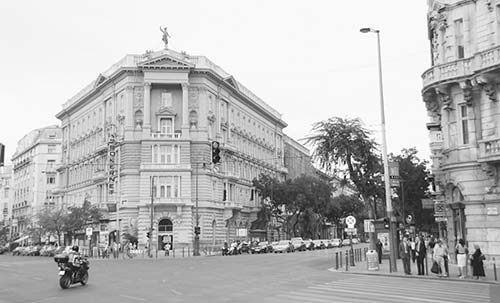
Built to get the masses conveniently out to Heroes’ Square for the millennium festivities, this fun and extremely handy little Metró line follows Andrássy út from Vörösmarty tér (Pest’s main square) to City Park. It was originally dubbed the “Franz Josef Underground Line”—in honor of the then-emperor—but later simply became known as the Underground (Földalatti). Just 20 steps below street level, it’s so shallow that you must follow the signs on the street (listing end points—ua Mexikói út felé takes you toward City Park) to gauge the right direction, because there’s no underpass for switching platforms. The first underground on the Continent (London’s is older), it originally had horse-drawn cars. Trains depart every couple of minutes. Though recently renovated, the M1 line retains its 1896 atmosphere, with fun black-and-white photos of the age.
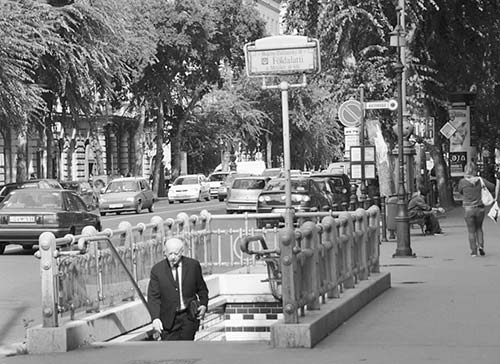
• From the top of the stairs here, notice the great view across the street to St. István’s Basilica. Now continue...
This grand boulevard—140 feet wide and nearly 2 miles long—was begun in 1871, when city bigwigs decided that on-the-rise Budapest needed an answer to Paris’ Champs-Elysées. But instead of leading to an Arc de Triomphe, Andrássy út culminates at the similarly triumphal Heroes’ Square. The boulevard also provided a convenient link between the dense urban center of Pest and the green expanse of City Park, allowing city-dwellers to zip out for a break from the bustle without plodding along congested narrow streets. The boulevard was officially inaugurated with much fanfare in 1885. Because most of the buildings were built within about 15 years, Andrássy út enjoys a pleasant architectural harmony. Historicism—a creative merging of various complementary styles—was all the rage at the time. Look up as you stroll to see the heroic statuary adorning the tops of buildings.
Since being built, this boulevard (and the major intersections along its length) has constantly changed names with the tenor of the times. Originally called Radial Boulevard (Súgarút), it was later christened for Count Andrássy, who had strongly promoted its construction (see sidebar). When the Soviets moved in, they renamed it Sztálin út; after the 1956 Uprising, it was briefly called Hungarian Youth Boulevard, before they re-dubbed it People’s Republic Boulevard. And finally, with the fall of communism, it regained its historical name: Andrássy út.
Running parallel to Andrássy út, two blocks to the right, is Király utca, which is lined with home-improvement shops (a hot commodity in this swiftly gentrifying city, where so many people are fixing up flats). This area—formerly the Jewish Quarter, and now more seedy than most parts of central Pest—is also home to the city’s distinctive “ruin pubs” (described on here).
• At your first opportunity—about a block and a half up from the underground station—cross to the left side of Andrássy út to find the next few attractions. As you cross, look to the far end of the street, where you can already faintly see the column that marks Heroes’ Square.
Once across the street, peek into the window of the Miniversum—a model railroad that curls its way through miniature buildings from Budapest and around Hungary. While you could pay to enter, you can see most of it from here.
This first stretch of Andrássy út is a cancan of big-money stores featuring international brands, such as Gucci and Louis Vuitton. But there are still some local shops—on the left, at #16, is a Herend shop, selling very expensive pieces of Hungary’s top porcelain (see here).
Upscale as it has become, Andrássy út remains an artery for the city, often clogged with traffic...except during “critical mass,” when 80,000 bikers take back the street twice a year (though these days it’s occurring more and more often—generally on weekends). During these times, the street is closed to traffic for a full day and given over to cyclists, in-line skaters, skateboarders, and pedestrians...a tempting taste of what could be.
On the left side of the street, on the corner at #20, look for the recommended Callas café, with sumptuous Jugendstil decor (for details, see here).

It was along this stretch of Andrássy út that Steven Spielberg filmed much of the 2005 film Munich, since the street has fine architecture that can stand in for many great European cities.
• On the left, just after Callas, is the can’t-miss-it...
The Neo-Renaissance home of the Hungarian State Opera features performances (almost daily except during outdoor music season, late June-early Sept) and delightful tours. The building dates from the 1890s, not long after Budapest had become co-capital of the Habsburg Empire. The Hungarians wanted to put their city on the map as a legitimate European capital, and that meant they needed an opera house. Emperor Franz Josef provided half the funds...on the condition that it be smaller than the opera house in his hometown of Vienna. And so, Miklós Ybl designed a building that would exceed Vienna’s famous Staatsoper in opulence, if not in size. (Franz Josef was reportedly displeased.) It was built using almost entirely Hungarian materials. After being damaged in World War II, it was painstakingly restored in the early 1980s. Today, with lavish marble-and-gold-leaf decor, a gorgeous gilded interior slathered with paintings of Greek myths, and high-quality performances at bargain prices, this is one of Europe’s finest opera houses.
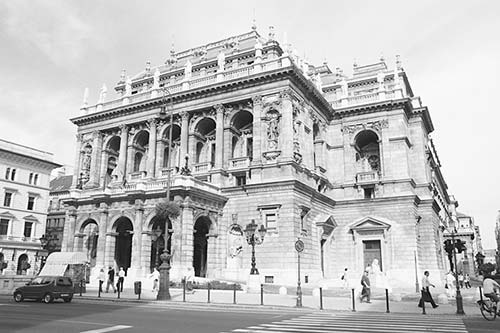
You have a few options for seeing this place. To just get a taste, slip in the front door when the box office is open and check out the sumptuous entryway. For the full story (and to get into the remarkable auditorium), take one of the guided tours in English (see here). To see the Opera House in action, take in an excellent (and refreshingly affordable) performance—for specifics, see here.
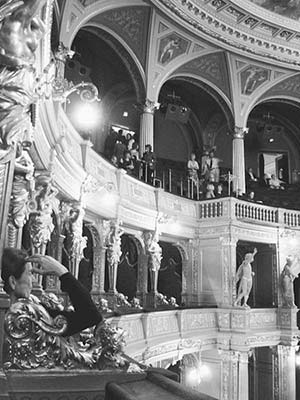
• The Opera House marks the beginning of an emerging dining-and-nightlife zone dubbed the...
• Cross to the right side of Andrássy út for the next few sights.
Across the street from the Opera House, and echoing its shape (although in a different style), is the Dreschler Palace. It was co-designed by Ödön Lechner, a leading architect whose works also include the Postal Savings Bank (see here). In this building’s late-19th-century heyday, one of Budapest’s top cafés filled its gallery. More recently, it housed the Ballet Institute. And not long ago, the beautiful but neglected building was purchased by a luxury hotel chain...but their plans fell through, and it’s still waiting for a new tenant. Tucked behind it is the New Theater (Új Szinház, with a fine Jugendstil facade), one of many popular venues around here for Hungarian-language plays (Paulay Ede utca 35, tel. 1/269-6021, www.ujszinhaz.hu).

A few steps up Andrássy út on the right (at #29) is another fine historic café, Művész Kávéház. As it’s a hangout for actors and musicians, this is your best chance to rub elbows with actual drama queens and divas (described on here).
The next major cross-street, Nagymező utca, features a chic cluster of restaurants, bars, and theaters (especially on the left side of Andrássy). This is an enjoyable place to stroll on a summer evening. While you might be tempted to attend a show along Budapest’s answer to Broadway, note that most of the plays and musicals here are in Hungarian only. So unless you want to hear “Music of the Night” sung in Hungarian (as it was meant to be), keep looking. (The Entertainment in Budapest chapter offers several more accessible alternatives.)
Continue straight across Nagymező utca, staying on the right side of Andrássy út. A half-block down on the right (at #39) is a grand old early-20th-century building marked Párisi Nagy Áruház (Paris Department Store), with a fine recommended café inside. Go in, and head up the escalator. One of the city’s first department stores, this was a popular shopping stop for years, even through communism. But as was common in Budapest, the store closed down and sat deserted and glum for years until investors came along to rescue it. The new owners, the Alexandra bookstore chain, turned the main area into a great bookshop, created office space above, and—inside, up the escalator at the back—fully restored the sumptuous Lotz Hall to create an excellent café with tinkling-piano ambience and reasonable prices (free entry, daily 10:00-22:00; for more details, see here). Upstairs is an art gallery and antique shop.
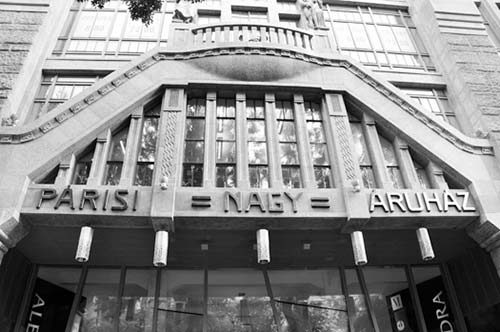
At the end of the block on the right (at #45) is a much humbler (but arguably more historic) bookstore: the Writer’s Bookshop (Írók Boltja). During Budapest’s late-19th-century glory days, the Japan Café at this spot was the haunt of many of the great artistic minds that populated the city, including architect Ödön Lechner and poet Attila József. Today the management still encourages loitering (and sells some English books).
• Just after the bookshop is a popular outdoor-dining area.
This leafy square is surrounded by hip, expensive cafés and restaurants. (The best is the recommended, kitschy, communist-themed restaurant Menza.)
Strangely, neither the statue on this square nor the one facing it, across Andrássy út, is of Franz Liszt. But deeper in the park, you’ll find a modern statue of Liszt energetically playing an imaginary piano. And at the far end of the square is the Franz Liszt Academy of Music, founded by and named for this half-Hungarian, half-Austrian composer who had a Hungarian name and passport. Liszt loved his family’s Magyar heritage (though he didn’t speak Hungarian) and spent his last six years in Budapest. His Academy of Music has been stunningly restored inside and out—step into the sumptuous lobby. This space, though smaller, gives the Opera House a run for its money...and speaking of money, the concerts here are much more affordable even than at the already reasonably priced Opera (for details, see here; for more on Liszt, see here).
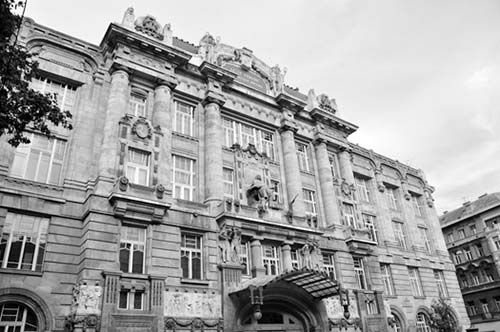
• One block up from Franz Liszt Square is the gigantic crossroads known as the...
This vast intersection with its corners snipped off—where Andrássy út meets the Great Boulevard ring road (Nagykörút)—was called Mussolini tér during World War II, then November 7 tér in honor of the Bolshevik Revolution. Today kids have nicknamed it American tér for the fast-food joints littering the square and streets nearby.
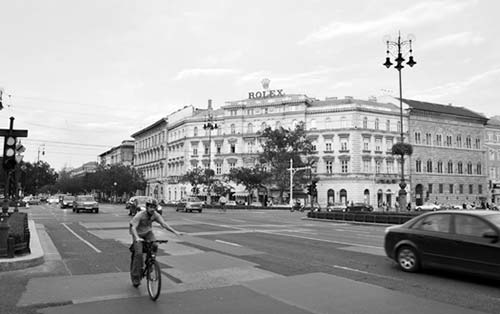
From here, if you have time to delve into workaday Budapest, hop on tram #4 or #6, which trundle in both directions around the ring road. If you’ve got time for a short detour to the most opulent coffee break of your life, head for the recommended New York Café (see here): Just hop on a tram to the right (tram #6 toward Móricz Zsigmond körtér or tram #4 toward Fehérvári út), and get off at the Wesselényi utca stop.
• There’s one more major sight between here and Heroes’ Square. Walk two more blocks up Andrássy út to reach the...
The building at Andrássy út 60 (on the left) has been painted a lifeless blue-gray, and the word “TERROR” is carved into the overhanging eaves. This is the place where two evil regimes tortured their Hungarian subjects. Now a modern museum documenting the terror of Hungary’s “double occupation”—first at the hands of the Nazis, then the Soviets—this is essential sightseeing for those intrigued by Budapest’s dark 20th century, and interesting to anyone.  See the House of Terror Tour chapter for a self-guided tour of the museum.
See the House of Terror Tour chapter for a self-guided tour of the museum.
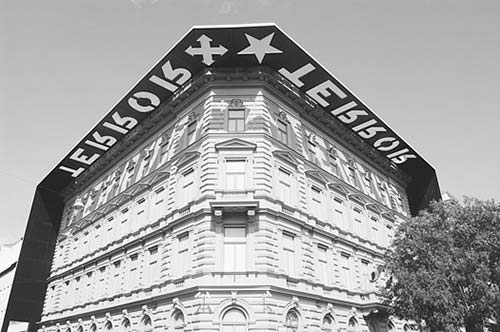
In the tree-lined sidewalk strip in front of the House of Terror, notice two other symbolic landmarks of that dark time: a chunk of the Berlin Wall, and an actual iron curtain of heavy, rusted chains.
• Two significant buildings stand across the boulevard from the House of Terror (on the right side of Andrássy út, just behind the Metró stop).
The yellow building on the corner of Vörösmarty utca (at Andrássy #67) is the former Academy of Music—founded by Franz Liszt and later moved to the building we just saw on his square. Upstairs is the small but endearing Franz Liszt Museum, in the old flat where the composer spent much of his time for the last six years of his life. This dusty collection might interest classical music buffs but will probably underwhelm most others. After putting on shoe covers, you glide through three rooms filled with period furniture and pianos (including ones custom-made for Liszt, and—on the lower shelf of a glass case—a “composing desk” with a small three-octave keyboard built by famous piano-maker Ludwig Bösendorfer). Liszt’s bedroom (to the right as you enter) contains his actual bed and a little personal altar where he knelt to pray. Look for the lithographs of Liszt sitting in this very room. The cupboard contains personal belongings, including a plate that belonged to writer (and Liszt friend) George Sand, and locks of the composer’s hair that were saved by his fans. In his heyday, Liszt was as adored as much as today’s biggest-name rock stars.
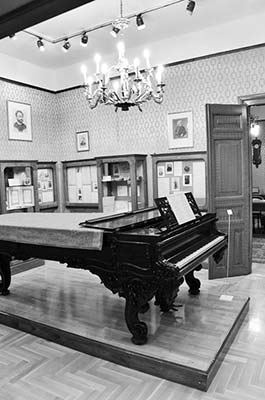
On Saturdays at 11:00, performances take place in the building’s small concert hall (for specifics, see here).
The next building is the Puppet Theater (Bábszinház), a venue for top-notch puppet shows (see here for details).
• While you can hoof it from here to Heroes’ Square (visible in the distance, about a 15-minute walk), there’s less to see along the rest of Andrássy út. If you prefer, hop on the Metró here (from right in front of the Puppet Theater) and ride it three stops to Hősök tere.
Or, if you continue walking up Andrássy út, after four blocks you’ll reach the grand intersection called...
This circular crossroads—which seems to echo the octagonal one we passed through earlier—is named for another great Hungarian composer, Zoltán Kodály (who lived in a mansion here, at #1, now a museum; for more on Kodály, see here). During the Nazi occupation, it had the jarring name Hitler tér.
Standing in the four wedge-shaped parks—overshadowed by the stately mansions surrounding them—are statues of four Hungarian heroes who fought against Ottoman invaders. Think of these as rejects from the Millennium Monument at Heroes’ Square just up the boulevard. In fact, two of the original statues from Kodály körönd were eventually “promoted” to the colonnade there, and their spots here were taken by two different heroes.
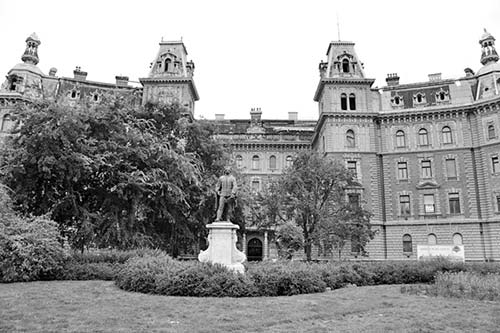
• After Kodály körönd, Andrássy út enters its final third, the...
Continuing up the street, notice that the buildings lining Andrássy út shrink and pull back from the busy boulevard, huddling behind trees. Instead of boasting bulky four- and five-story apartment blocks, it turns into a sleepy, leafy residential zone. These villas were formerly occupied by aristocrats, diplomats, and wealthy Jews. Today this is where many foreign states maintain their embassies. If you’d like to skip the final stretch, you can hop on the Metró at Kodály körönd. Or, to complete your stroll, keep going.
• Andrássy út terminates at Heroes’ Square. See the Heroes’ Square and City Park Walk chapter.